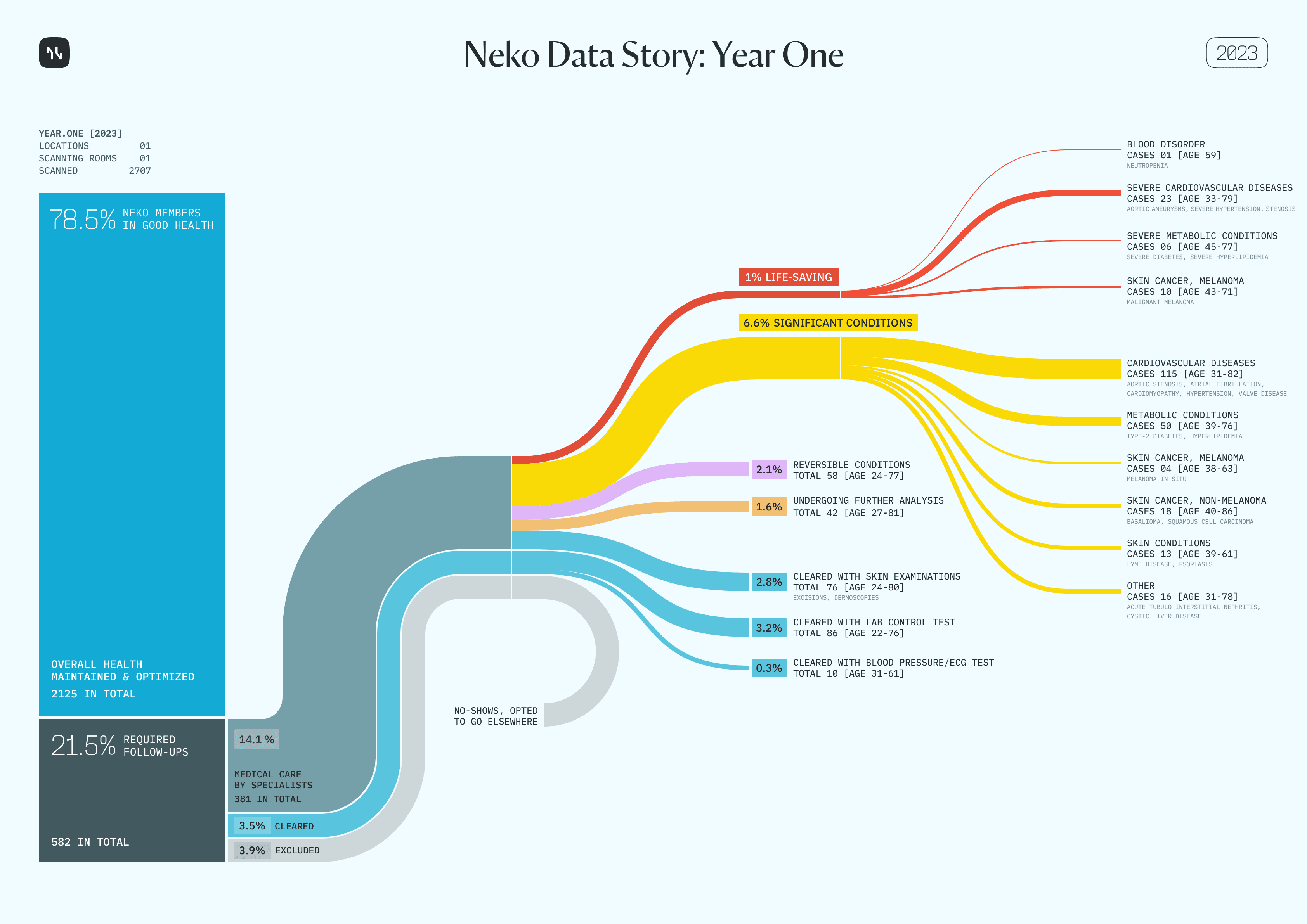Neko Data Story: Year One
A bit over a year ago, we opened our first Neko Health Centre in Stockholm, driven by the mission to build a proactive healthcare system focused on disease prevention. Since then, thousands have come to do a Neko Body Scan. Today, we want to share the data that we’ve gathered.

We’ve looked at the outcome data from 2,707 people who were scanned between 2nd February and 31st December 2023. This data is based on the referrals and secondly the diagnosis received after the Neko Body scan. Referrals were made to our own primary care clinic, though 3.9% were excluded as they chose to go to their own doctor for example or decided to not come. While this is not a scientific study with a control group for comparison, we would like to share our outcomes for transparency and knowledge sharing.
Key Findings:
The age range for males who underwent a scan was 18 to 81 years old, with an average age of 47 years. For females, the age range was 22 to 75 years old, with an average age of 49 years.
Healthy majority – overall health maintained & optimized: For 78.5% of people scanned, our examinations showed no health issues or need for further examination.
Medical treatment initiated: 14.1% of the people who underwent a Neko Body scan needed medical treatment and monitoring. This included diseases that were life-threatening or could cause serious injury, diseases of moderate severity, or mild conditions:
Life-saving /avoidance of severe injury: 1% of all people that we scanned received a potentially life-saving intervention. These interventions addressed severe conditions such as cardiovascular diseases (e.g. aortic aneurysms, severe hypertension, and stenosis), severe metabolic diseases (e.g. severe diabetes, severe hyperlipidemia) and skin cancer (malignant melanomas). None of these people were aware of their condition prior to their visit. The age range was 33 to 79 years old. Notably 1 in 4 individuals (26%) who were diagnosed were under the age of 50.
Significant health conditions: 6.6% of the people scanned had a moderate to severe health condition. Through detection of conditions such as heart diseases (e.g. non-rheumatic aortic valve disorder, hypertension, atrial fibrillation), type 2 diabetes, and skin cancer, timely interventions were made possible. Majority of the people (90%) were not aware of their condition or had any symptoms prior to the visit. The age range was 31 to 86 years old. 1 in 3 (28%) who were diagnosed with significant conditions were under the age of 50.
Reversible conditions where primary prevention was initiated: 2.1% of the people showed early signs of health issues such as elevated blood pressure, increased blood sugar levels, abnormal heart rhythms, or pre-cancerous skin conditions. By successfully identifying these risks, we can now monitor and guide them towards preventive measures. The age range was 24 to 77 years old.
Cleared with skin examinations: 2.8% of the people were cleared with a skin follow-up through short term monitoring with dermoscopies and excisions, according to medical guidelines.
Undergoing further investigation: 1.5% of the people are still undergoing further investigation and the final diagnosis has yet to be determined.
Cleared: 3.5% of the people were cleared through follow-up tests within our clinics, covered by Neko Health. After the control tests, no further examination was needed (e.g. ECG, control blood tests and BP). These follow-up tests were offered in order to minimize false positives and unnecessary burden to the healthcare system.
Others: Lastly, 3.9% of the people referred were excluded from further analysis as they opted to follow-up at other clinics, cancellations, or no-shows.
Finally: 76% of all the individuals who underwent a scan (2,707 in total) chose to rebook a scan for the following year.
Note & Disclaimers
*Atrium is a primary care clinic owned by Neko Health and is a part of the Swedish national health service. The cost of members being referred to Atrium is covered by Neko Health. In the recent National Patient Survey 2023, Atrium was among the top 10 nationally out of 1200 primary care clinics, and top 5 in Stockholm, in just over a year after opening.
Source: Sveriges Kommuner och Regioner (2024). Nationell patientenkät. Available online: here.
*The total number of diagnosed conditions is higher than the number of individuals in the "Life-saving /avoidance of severe injury" and "Significant health conditions" groups as some people had multiple diagnoses.
Change country
Choose country to see health centres and content specific to your location.